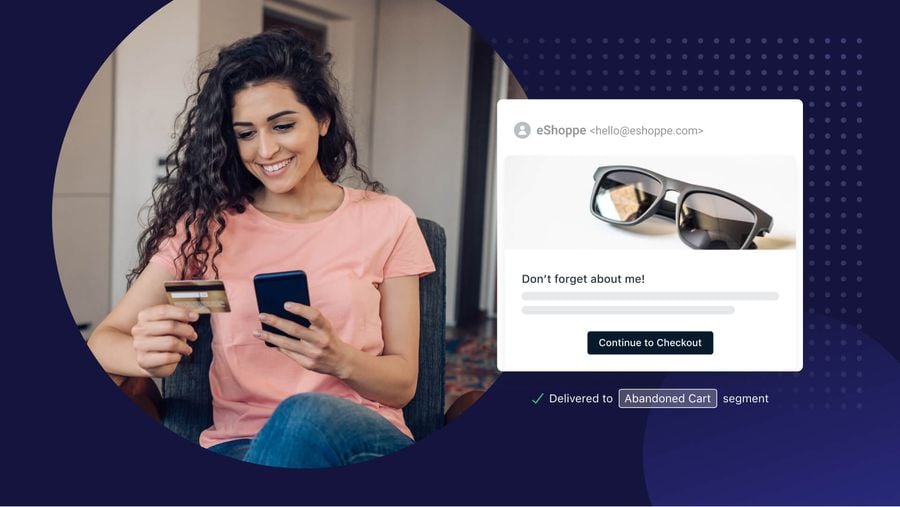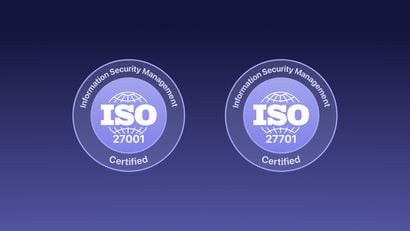Email marketing campaign best practices — they’re a dime a dozen and all too often adopt a “one glove fits all” approach. If you are writing your campaigns using this same logic, you are committing the cardinal sin of email marketing: blending into your recipients’ inboxes. Much like you wouldn’t expect to catch every fish in the sea using the same type of bait, you cannot expect your emails to convert by simply sending everyone on your list the same exact thing.
Email marketing segmentation ensures your campaigns are targeted and relevant to specific groups of recipients on your email list. The goal? Open, convert, and retain!
If you take nothing else from this article, just remember this little bit of karmic marketing advice: you only get out what you put in.
Continue your email campaign education with our comprehensive (and free) guide to email optimization. We walkthrough everything from email compliance regulations to which email KPIs you should be focused on.
What is Email Segmentation?
Email marketing segmentation is the practice of dividing your email subscriber list into smaller, distinct groups based on specific criteria or common characteristics. The goal of all email segmentation strategies is to tailor your marketing messages to each segment and inspire action based on the specific interests, preferences, and needs of those segments.
Yes, email marketing has remained a low-cost and time-tested way to position your brand in a place that most people check daily. But we live in an age of misleading spam, digital clutter, and tone-deaf promotions.
If your emails aren’t relevant, they are invisible to the eyes of your subscribers.
Your email list is not one singular entity, but a collection of diverse audiences who all require different paths to their inbox. You don’t want to be reaching everybody with the same message — instead, focus on reaching the right people with the right message.
Benefits of Email Segmentation
Every customer journey begins with messaging that resonates. Email segmentation lays the groundwork for sending email campaigns to the recipients most primed to open them.
By segmenting your email list, you achieve a results-driven domino effect:
- Higher engagement
- Increased open rates
- Better click-through rates
- More conversions
- A clearer understanding of your audience sub-types
Understanding Your Audience
The purpose of segmenting your email list is to address your subscribers on terms defined by their needs. Before you can begin to segment your audience, you must first collect accurate data to inform your email segmentation strategy. One of the most effective ways to do this is through the creation of buyer personas. Buyer personas are fictional representations of your ideal customers based on research and data. How is this data collected?
Conduct Market Research
Start by conducting market research and gathering data about your existing customers. In-app surveys, interviews, focus groups, and social media research are all great ways to gather insights and start organizing your personas. Look for commonalities, patterns, and trends among your customers to identify key characteristics.
Analyze Demographics
Now you can begin to build a foundational understanding of your customers and their backgrounds. Use demographic information such as age, gender, location, occupation, income, and education level.
Identify Psychographics
Time to get detailed. Dive deeper into your customers' psychographics, which includes their interests, hobbies, values, attitudes, and lifestyles. This information helps you understand their motivations, preferences, and behaviors, all of which are core purchase drivers.
Uncover Pain Points
Customer pain points are your best friend, get familiar with them. Identify the challenges, common complaints, and workarounds that your customers share related to your product or service. This information not only helps you avoid product potholes as you develop your platform but it allows you to tailor your marketing messages to address their specific needs.
Determine Buying Behavior
How do your customers research products? How do they make purchase decisions? What are their preferred channels or platforms? These insights help you align your email segmentation techniques accordingly.
Create Persona Profiles
Once you have gathered and analyzed the data, create fictional personas that represent the different sub-groups of your target audience. Each persona should have a name, photo, demographic details, and a narrative description that brings them to life.
Use Personas for Data Collection
With your new personas in hand, use them as a guide for collecting data. When conducting surveys, interviews, or analyzing customer data, ensure that you capture information relevant to each persona. This allows you to segment your data and gain insights specific to different customer segments.
Remember, personas evolve over time as you gain more information and understanding of your audience. Make sure to regularly update and refine your personas to ensure they remain representative of your target customers!
Types of Email Segmentation
You have your data — now comes the fun part. While there is a nearly limitless combination of ways to segment your audience, these are a few of the most successful.
1. Geographic Segmentation (Also Known as Geotargeting)
This email segmentation strategy divides a target market into different segments based on their location. Customers can be categorized by country, region, city, climate, or population density. For example, Starbucks may tailor their email marketing with a climate-based segmentation to promote hot or cold drinks depending on where they are more likely to be purchased. Alternatively, they may leverage regional segmentation in specific Asian countries where tea-based beverages are more popular.
2. Customer Lifecycle Segmentation
This email segmentation strategy involves dividing your customer base into distinct segments based on where individuals are in their relationship with your company. You wouldn’t speak to a dormant customer who you are attempting to re-engage the same way you would to a brand-new customer who is still in the onboarding process. Customer lifecycle segmentation is a powerful strategy for increasing engagement and maximizing customer lifetime value.
The data most useful for customer lifecycle segmentation includes purchase history, customer pain points, and feedback.
3. Purchase History Segmentation
Most people have repetitive purchase habits, meaning it is easy to predict future purchases — and tailor your email campaigns to help grease the wheels of purchase intent. Purchase history segmentation is based entirely on customer behavior and is a valuable approach for email marketers.
For example, if you run an eCommerce store, you can send specific product recommendations or discounts to customers who have previously purchased from a particular category. Alternatively, you can target inactive subscribers with re-engagement campaigns or send different versions of your newsletter based on subscribers' past buying preferences.
Remember, email segmentation is based on relevancy. If your customers have already proven to gravitate towards a particular product of yours, help them lean into similar or auxiliary products. Better yet, use purchase history segmentation as part of your upselling strategy.
4. Engagement-Based Segmentation
Engagement-based segmentation helps you understand which customers are actively interacting with your brand, showing interest, and potentially more likely to convert or make repeat purchases. By segmenting customers based on their engagement level, you can create targeted campaigns and deeper, more personalized experiences to nurture customer relationships.
For example, you may create a segmentation for high-engagement customers, or those who have consistently interacted with your brand across multiple channels or have proven to be frequent email openers. You may reward this segment with exclusive offers or another form of VIP treatment to maintain their loyalty and further incentivize their engagement. On the other side of the spectrum, low-engagement customers may need a more personalized tone of voice or a series of special promotions to help bring them back to the table.
Take abandoned carts for example. These customers have already demonstrated purchase intent, but have not completed their order. A well-timed cart recovery message is often all it takes to recapture potential customers whose attention has been diverted from your platform. Low-engagement customers are seldom lost — more often than not, these customers represent money left on the table who simply need the right re-engagement campaign.
How to Segment Your Email Lists
When you’re ready for the rubber to meet the road, it’s time to divide your email list into distinct segments based on the criteria you've identified. Each segment should be mutually exclusive and collectively exhaustive, meaning subscribers should fit into only one segment and all subscribers should be included in at least one segment.
Many email marketing platforms offer built-in email segmentation features that provide user-friendly interfaces and automation capabilities to help streamline the segmentation process.
You will first need to utilize a contact management system (CMS). This is where you will store and organize the subscriber data you’ve already collected. You can import and manage subscriber demographics, purchase history, and engagement data here. Depending on the platform, you will most likely have a virtual dashboard with options for various conditions and filters to define and refine your segments.
Make sure your email marketing platform supports automation. Email lists are large and in a constant state of flux, meaning you’re going to need to save some serious time if you are to segment your entire subscriber base AND keep it up to date. Not only that but being able to personalize content at scale requires intelligent automation for businesses with growing email lists.
Automation features should enable you to set up workflows triggered by specific actions or conditions. These workflows allow you to send targeted emails to specific segments based on predefined triggers, such as a subscriber's behavior or a specific date. Automation helps ensure that the right content is delivered to the right segment at the right time.
For example, OneSignal’s Data Tags automatically keep your email lists up-to-date and assist in segmenting subscribers based on real-time interactions with your app or website. Are you a marketer looking for a drag-and-drop segmentation solution that shines on every device? We built our Email Composer specifically for you. Free templates, an integrated segmentation editor, and HTML editor (for those who prefer full control) create what’s equivalent to a limitless email marketing sandbox.
Ready to start driving results with OneSignal Email? Look no further.
A Clean Email List is a Converting Email List
Once every quarter, go through your current email list and reorganize or remove inactive email addresses. By removing duplicate emails, correcting formatting errors, and identifying dormant users, you can very easily increase the effectiveness of your email campaigns. A clean email list also reduces the likelihood of your marketing campaigns being classified as email spam. If your campaigns are mistakenly perceived as spam, this could negatively effect your reputation with your ESP or even get you into hot water with one of the numerous anti-spam laws around the world.
Make sure to read up on both the CAN-SPAM Act (US) and GDPR (EU). These anti-spam laws outline specific email compliance guidance for obtaining explicit consent, providing clear opt-out options within emails, and numerous data security measures. These anti-spam laws carry severe penalties and are strictly enforced, so it’s important to stay up to date with email marketing best practices and keep your reputation strong.
When you’re ready to clean your email list, use this guide to get started!
Reading The Room – Crafting Personalized Email Content
Once you’ve identified your subscribers’ interests, preferences, and buying habits, you will use that information to inform your email copy. Building lasting trust with your customers begins with crafting copy that stokes the emotional touchpoints of each and every individual.
Customized Offers and Promotions
Segmentation enables you to personalize your offers and promotions based on the preferences and behaviors of each segment. Create exclusive discounts, product recommendations, or incentives that align with the unique purchase history of each segment you’ve identified. Personalized offers increase the chances of driving conversions and continued engagement.
Dynamic Content
Email segmentation allows for the use of dynamic content within your emails. Dynamic content blocks can be customized to adapt to each recipient's segment. This often means utilizing different subject lines, greetings, body content, or images based on your segmentation criteria.
Behavioral Triggers and Automation
Segmentation allows you to set up automated workflows and triggers based on specific subscriber behaviors or actions. For example, you can automatically send a follow-up email with additional information to subscribers who clicked on a specific link in a previous email. By automating personalized responses based on individual interactions, you can create a more personalized and timely email experience.
Language and Localization
Geographic segmentation enables you to personalize email content based on the language, culture, or location of your recipients. By delivering emails in their preferred language or tailoring content to match their local context, you create a more personalized and relatable experience.
Testing and Optimization
Segmentation is not a “set it and forget” strategy. Just as your customers’ behavior and preferences change over time, so too will your segmentation groups. Staying up to date and keeping your email campaigns relevant requires a combination of data analysis, customer feedback, and a deep understanding of your audience.
You should regularly review the performance metrics of your segmented email campaigns. Track key metrics such as open rates, click-through rates, conversions, and customer engagement levels for each segment. Identify segments that are performing well and those that may need adjustment.
Keep the lines of communication as open and inviting as possible with your audience. Gather feedback from your audience through surveys and polls. Ask questions that help you understand their changing preferences, needs, and behaviors. This information can provide valuable insights for refining and adjusting your segmentation criteria.
Lastly, embrace the A/B test! A/B testing allows you to test different versions of email content or offers to see which performs better with specific segments. Do your subscribers prefer a professional tone in their subject lines or something a little more playful? Which email images resonate most and capture readers’ attention? By analyzing the results of your A/B test, you can optimize your campaigns and deliver the most effective content to each and every segment.
If you’re a marketing mad scientist who's ready to begin experimenting, start optimizing your email performance with A/B testing and find out just how easy it can be.
Email Targeting – Don’t Settle For Anything Less Than a Bullseye
Email marketing is truly where the left brain meets the right. Your messaging should be emotionally compelling and creatively framed to set your brand apart from the rest. But the difference-maker between a clever campaign and a successful campaign hinges on your ability to make data-driven decisions. Email segmentation demonstrates one of the best ways of leveraging real consumer data to help and build stronger relationships with your subscribers, ultimately driving higher (and healthier) engagement.
Personalized cross-channel messaging — it’s OneSignal’s bread and butter. Our email platform is quick to set up and built to save you money without sacrificing control. Our Segmentation tool is designed to build engagement, reduce churn, and grow user loyalty over time. It even plays nice with existing eligible email providers like Mailgun, SendGrid, and Mailchimp.
Create a Free Account



